- This article is about the military of the Fire Nation. For other similar uses, see Military (disambiguation).
The military of the Fire Nation is the unified armed forces of the Fire Nation. It was the world's most powerful military during the Hundred Year War, and saw many glorious victories in battle throughout the span of the conflict.[2]
The Fire Lord is the commander-in-chief of the Fire Nation military and delegates power through a select few generals and admirals of the army and navy, respectively. The War Minister develops and provides technology and equipment for the Fire Nation military and reports directly to the Fire Lord.[3] At least prior to the Hundred Year War's end, female Fire Nation soldiers mainly served in the homeland.[4]
A large number of personnel comprise the Fire Nation military, of which the majority are volunteers, though in war times conscription also does occur. The Fire Nation's army is the second largest in the world in terms of numbers, after the Earth Kingdom, and it maintains the largest navy. The Fire Nation military also possesses advanced and powerful military equipment, giving it huge military capabilities and power projection solidifying itself as the most powerful military force in the world.[2] The only known force capable enough to match the Fire Nation military head-on was the military of the Earth Kingdom, though it very often experienced major losses against the Fire Nation.
Army
The Fire Nation Army is comprised of both nonbending foot soldiers, who normally wield spears, swords, and shields, and firebenders. During the Hundred Year War, this army was the strongest in the world, capable of almost any military ground operation.[2]
History
The first colonies
Around 37 BG, the Fire Nation Army successfully attacked and occupied a region of the western Earth Kingdom on the order of Fire Lord Sozin. The conquered territories were designated as colonial possessions, and although Sozin had intents to take over more land, his plans were halted by Avatar Roku, who opposed aggression and imperialism. Nevertheless, the status of these first colonies did not change, and they continued to serve as bases of operation for the military.[5][6]
The Hundred Year War
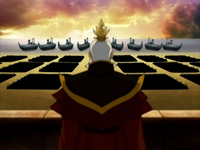
Fire Lord Sozin prepared his forces to start his expansion of the Fire Nation.
However, the Fire Nation Army would eventually wage war for one hundred years.[2] After the death of Avatar Roku, they harnessed the power of Sozin's Comet to destroy the Air Nomads, though not without suffering their own casualties from the resisting airbenders. However, they failed to kill Avatar Aang, who escaped before the Air Nomads were all killed.[7] After destroying a whole nation, the Fire Nation troops began to fight the two remaining hostile nations, the Water Tribes and the Earth Kingdom. Using the colonies as bridgeheads, they destroyed many Earth Kingdom cities in the following years, devastating the western kingdom. The army won many battles during these early stages of the war, including the Battle of Han Tui, the Battle of Garsai, and the infamous destruction of Taku.
After Sozin's death and Fire Lord Azulon's crowning, the Fire Nation Army achieved even more victories. Around 40 AG, the army joined forces with the Fire Navy and attacked the Southern Water Tribe, killing or imprisoning all of the waterbenders there, leaving only the nonbenders to suffer constant Fire Navy raids for the next several decades.[8] For the rest of Azulon's reign, the army fought the Earth Kingdom and succeeded in conquering most of its western territory. The Fire Nation troops left much suffering and destruction in their wake.[2]
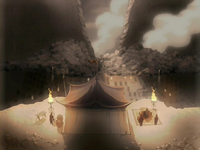
There was a Fire Nation camp outside the walls of Ba Sing Se during the six-hundred day siege.
Six years before Aang's awakening, General Iroh led the army in attacking the Earth Kingdom capital of Ba Sing Se in a six hundred-day siege. The army destroyed the Outer Wall and attacked the Agrarian Zone, only to be pushed back when Iroh called a retreat after earthbenders killed his son, Prince Lu Ten.[9] This failed attack would dishonor Iroh for years to come. Nevertheless, it was the first time that an army had been able to breach through the walls of Ba Sing Se, something even previous earthbending armies had not accomplished. Therefore, the siege had a major impact on the morale of both fighting armies – while the morale of the Fire Nation Army was boosted, the Earth Kingdom soldiers faced a terrible shock.[2]
During the year in which Avatar Aang awoke from the iceberg, namely late 99 AG, the Fire Nation Army prepared several several massive offensives to end the already crumbling resistance of the Earth Kingdom and the Northern Water Tribe. However, around this time and due to Team Avatar's involvement, uprisings of earthbenders and Earth Kingdom civilians in occupied territories began to occur. After several imprisoned earthbenders were able to escape from a Fire Nation prison rig, they formed a militia and began to fight the army in a guerrilla war at the western Earth Kingdom coast. Another obstacle to the Fire Nation rule that had arisen in the western kingdom were the Freedom Fighters, a guerrilla group determined to rid the world of all firebenders. While the latter was dissolved after a scuffle with the more moderate Team Avatar, the former remained active until summer 100 AG. The army faced considerable difficulties in hunting down these guerrillas and minimize the damage they did to logistics, infrastructure and colonies.
In early 100 AG, the army tried to conquer the Northern Air Temple a second time, since local refugees living in the temple had opposed the authority of the Fire Nation. The army employed hundreds of foot soldiers and a contingent of tanks to overwhelm the defenders in their almost inaccessible mountain fortress, accessible by only a single path. Despite considerable resistance from the refugees, their air forces, and Team Avatar, the tanks soon reached the walls of the temple. The battle ultimately ended in a defeat, however, as the defenders, in a last desperate act, intentionally caused a massive natural gas explosion under the temple; both the cliffs and path to the temple were destroyed, while almost all Fire Nation forces were killed in the explosion. The confrontation was not a complete loss, however, as War Minister Qin discovered an abandoned hot air balloon during the battle, technology that would give the Fire Nation a major advantage during the final stages of the war.[3]
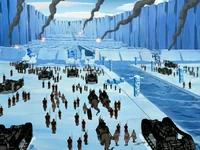
The Fire Nation siege force advancing toward the Northern Water Tribe.
Later on, Admiral Zhao launched a massive invasion force to attack the Northern Water Tribe in what is now known as the Siege of the North. Thousands of soldiers and dozens of tanks attacked the Water Tribe Capital, but they were met by the extremely powerful waterbenders who defended the city.[10] When Zhao killed the Moon Spirit, the Fire Nation Army had full control of the city, but they were annihilated by Avatar Aang when he became one with the all-powerful Ocean Spirit. Any remaining survivors retreated, while Zhao was imprisoned in the Fog of Lost Souls in the Spirit World.[11] The Moon Spirit was soon restored due to Yue's sacrifice and the Water Tribe was saved.[12]
Sometime later, the Fire Nation Army conquered the Earth Kingdom city of Omashu and replaced the imprisoned King Bumi with one of the Fire Nation's governors. Despite the Omashu Resistance, the Fire Nation forces had a strong hold on the city. With the fall of Omashu, later renamed New Ozai, the Fire Nation Army occupied almost all of the western and northern Earth Kingdom territories.[13] A few months later, after a successful coup d'état led by Princess Azula and the Dai Li, the Fire Nation Army occupied Ba Sing Se, finally conquering the capital of the Earth Kingdom.[14]
The Fire Nation Army was left in almost complete control of the Earth Kingdom with the fall of its mighty capital and Avatar Aang's defeat. However, even with Ba Sing Se in its control, the Fire Nation Army was met with a determined resistance who threatened the army's hold of the country, even pushing back the army in territories of secondary importance. On the Day of Black Sun, the Fire Nation Army suffered a crushing defeat when King Bumi broke out of prison in Omashu and took advantage of the army's temporary loss of firebending to single handedly liberate his city.

Fire Nation Army troops and tundra tanks fighting desperately but in vain against the deserter Jeong Jeong during the liberation of Ba Sing Se.
The Fire Nation Army's final defeat came with the liberation of Ba Sing Se on the return of Sozin's Comet, when the Order of the White Lotus assaulted the city and utterly crushed the occupying forces with their advanced bending skills. The defeat of Fire Lord Ozai in the concurrent battle at Wulong Forest and Azula's downfall during an Agni Kai with her brother effectively secured the surrender of the Fire Nation Army.
With the end of the Hundred Year War, Zuko was crowned the new Fire Lord, announcing world peace, while the army, now under his control, withdrew from the occupied territories all over the world. This action caused many military personnel to lose their occupations and set out on their own.[15]
Harmony Restoration Movement
Throughout the following year, the Fire Nation Army was reformed and remained inactive until the escalation of the Harmony Restoration Movement. After recognizing that reforming the Fire Nation colonies was a better and less disruptive solution than total abandonment, Fire Lord Zuko officially withdrew his support of the Harmony Restoration Movement. He barricaded Yu Dao, the most significant colony and main opponent of the movement, announcing that no one was to leave or enter the city without his permission. His order was enforced by the Fire Nation Army troops that were stationed in the city.
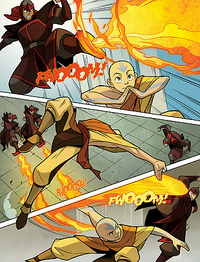
Firebending guards fighting Aang to drive him out of Yu Dao.
Zuko's decision resulted in protests of Earth Kingdom loyalists, especially the Freedom Fighters. However, nonbending guards of the Fire Nation Army protected Yu Dao from these protesters.
Later on, when Avatar Aang arrived, he and Katara easily entered the city via the Avatar's glider staff. In Yu Dao, they were warned by firebending guards to leave the city since they had no permission, but the Avatar demanded to speak with Zuko. The dutiful guards attacked the Avatar, but were easily defeated by Katara. One soldier tried to attack again, but the waterbender geared up to harm him before Zuko appeared, grabbing and admonishing her for attacking his people. His arrival led to a scuffle, during which Zuko agreed to another talk with Earth King Kuei in hopes of achieving future peace.[6]
However, when General Mak informed Zuko later on that Earth King Kuei was preparing to invade Yu Dao, the Fire Lord deployed his fleet and army to defend the colony from the Earth Kingdom Army.[16]

The Fire Nation Army attacking during the battle for Yu Dao.
Due to the short time available to him, Zuko employed a small but effective task force of many infantrymen, komodo cavalry, and some tundra tanks to stop the Earth King's army and save Yu Dao. Even though his troops advanced quickly, the Fire Nation Army arrived after the Earth Kingdom Army. When both armies were about to attack each other, Sokka and Toph appeared from one of the tanks which they had secretly hijacked before, and upon Sokka's command, Toph metalbent all the screws from the tundra tanks around them, essentially disabling them. Fire Lord Zuko, outraged and determined, ordered his men to start fighting on foot and with the cavalry, beginning the battle for Yu Dao. In order to avoid unnecessary bloodshed, Team Avatar intervened, fighting both the Fire Nation and Earth Kingdom troops. However, the Fire Nation Army, even without the aid of heavy weapons, was able to withstand both the Earth Kingdom Army with its still operational heavy tanks and the elite fighters of Team Avatar. Nevertheless, Team Avatar's involvement resulted in a ceasefire and an agreement between Earth King Kuei and Fire Lord Zuko, allowing both armies to withdraw peacefully.[17]
Infantry
The infantry, as part of a volunteer and standing army, has an excellent moral that borders on fanaticism, is highly trained and very effective. Notably, there are cases of Fire Nation infantrymen known that fought huge monstrosities and spirits head-on without the chance of victory or survival, rather than surrendering, deserting or fleeing. Another example of the almost fanatical mindset of Fire Nation infantrymen was given during the Air Nomad Genocide; to kill a single airbending master, dozens of soldiers gave their lives without retreating. The nonbenders and firebenders fight together in joint companies, often operating with tanks or cavalry. Overall, the Fire Nation infantry is flexible, and due to their high moral and good training, commanders can entrust them with several different tasks.[6][12][17]
However, before the end of the Hundred Year War the army was far larger, and a strict separation of benders and nonbenders both on the equipment and in combat existed. The infamous helmets with faceplates were worn exclusively by firebenders, while nonbenders got only cone helmets.[2] This separation ended under the reign of Fire Lord Zuko, and equipment was issued as needed and by competence. For example, nonbending guards got the infamous red and black armor and faceplates to scare off the Freedom Fighters during the Yu Dao-crisis in 101 AG. In addition to this, after the reforms of Fire Lord Zuko, the formerly vast Fire Nation Army became more compact, but also more effective.[6][17]
Uniform
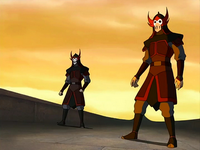
Many firebenders are equipped with heavy armor.
Fire Nation soldiers are recognizable by their red and black armor. However, there are two types of armor which are equipped for different purposes.
The first type, the heavy armor includes a cuirass, tassets, a combination of shoulder pads and armored collar, and heavy boots. However, most recognizable element is its special helmet with neck guard, a flame-like crest and an intimidating faceplate shaped like an abstract skull. This armor provides excellent protection and is also suited for psychological warfare. The heavy armor is mainly used by heavy infantry and tank crews. Even though ranking officers use this armor, they do not wear faceplates, as they make it difficult to speak properly. In cold climates, the heavy armor is supplemented by lined trousers and a warm jacket.[12][17]

Fire Nation infantrymen were equipped with light armor and winter gear during the Siege of the North.
The second type is the light armor. It includes a simple cone helmet with leather neck guard, a combination of shoulder pads and armored collar and a leathern, sleeveless robe, and heavy boots. As the most common armor, it is used by almost two thirds of the infantry. Even though the light armor does not provide excellent protection, it is largely fire resistant and provides adequate protection against projectiles. For the fighting in cold climates lined trousers, a gray overcoat, gloves, a scarf, and a woolen cloak are added to the light armor.[12][17]
Generally, the Fire Nation appears to update their uniforms every so often. In around 15 AG, uniforms had large, protruding shoulder spikes. In 100 AG, the uniforms are more streamlined.[10]
Training
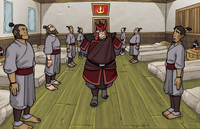
A drill sergeant giving new recruits a terrifying speech.
Despite the fact that the Fire Nation sometimes lacked enough soldiers to effectively secure conquered regions in the vast Earth Kingdom,[18] the Fire Nation Army never drafts their soldiers forcefully, but instead relies on massive propaganda to convince volunteers to join the military.
After joining the army, the volunteers are enrolled into several companies and thereafter taken into boot camps. In these camps, they have to endure harsh training, and sometimes also the capriciousness of their officers. However, even though the recruits are driven to the extreme, their training is also effective and strengthens their bodies and minds for the fight. They learn all kinds of different abilities, from necessities like how to handle their weapons or basic discipline to useful extras, like how to ride a komodo rhino in spite of being infantrymen. In addition, the officers often use verbal abuse and the hard training to break the civilian thinking of the recruits, only to raise them again as courageous and pugnacious soldiers. This training eventually form the fearsome Fire Nation soldiers.[19]
Equipment and weaponry
Nonbending soldiers typically use spears, but sometimes also swords, shields, crossbows, pu dao, halberds and knives as their means of warfare. Firebenders rely mainly on their bending abilities, but they can obtain weapons when it is required, for example in emergency situations like solar eclipse.[17]
As the most advanced nation of its time, the Fire Nation employed a multitude of heavy vehicles and machines for conventional warfare. Most of their technology also derives off of their firebending abilities, allowing them to power coal-based technology and weapons.
Tanks
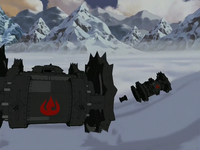
Fire Nation tundra tanks were used in the battle for the Northern Air Temple.
The most important heavy weapon the Fire Nation Army employs is the tundra tank, the first mass-produced tank in the world and a light tank. These tanks are heavily armored and equipped with fire ports to allow the crew to launch fireballs, as well as two grappling hooks on the front. However, the unmodified tundra tanks are only able to fight infantry due to the lack of anti-tank or generally heavy weapons, thus their classification as light tanks. They are built with the main body separated from the tracks with a complicated hydraulic suspension which enables them to right themselves if flipped over, but leaves them vulnerable to waterbending and metalbending.
Tundra tanks are great all-around vehicles, able to be used in tundras, mountains, deserts, grassland and urban area. Although they are inferior to their counterparts, the earthbending-powered tanks of the Earth Kingdom, they are a serious threat, especially when they are used in joint companies with infantry.[3][17]
Artillery
The Fire Nation Army uses metal semi-automated catapults, or trebuchets, for larger operations. They work by using a large bar holding a metal net with a coal-ball inside it. The coal ball is ignited and a pedal is hit with a mallet causing the bar to fling over and toss the ignited coal-ball into the air.
Cavalry

Komodo rhinos were used during the Siege of the North.
The army makes use of komodo rhinos. Outfitted with heavy armor around the face, they are used as cavalry, for cart pulling, and can even be mounted with two catapults. Fire Nation soldiers mount these frightening beasts to terrorize their enemies.[2]
The drill
- Main article: Fire Nation drill
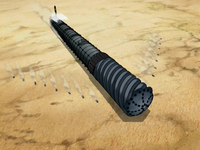
The drill was used to drill through the outer wall of Ba Sing Se.
This siege engine was a massive drill, designed to breach the Outer Wall of Ba Sing Se. The drill was originally modeled by the mechanist and took over two years to construct. As large as a village, it housed an entire brigade of Fire Nation engineers, who were needed to make repairs and clean out pipelines. The drill was composed of two moving parts which were connected by a series of braces. It worked by tearing chunks of stone from structures and grinding them down, dispensing them into water and channeling them out the rear.[20]
Strategies

The Siege of the North showcasing a typical Fire Nation Army attack: Artillery weakening the defenses, while tundra tanks and cavalry act as a spearhead to break the defenders. Infantry units follow the heavy troops to secure the gained ground.
The Fire Nation Army uses strategies that are similar to the characteristics of its representative element; it is highly mobile and aggressive in combat, but also acts clever and cunning, preferring complex strategies over brute force.
A typical Fire Nation Army strategy is as follows: Infantry companies of firebenders and nonbenders try to outflank their enemies, avoiding defenses too strong for them, using terrain and even environmental conditions like wind to their advantage. The infantry advances steadily, securing gained ground. At the same time, heavy units like tanks and cavalry act as spearheads and break the enemies' strongholds. If needed or available, artillery provides additional suppressive fire. In the best case the troops are able to encircle the enemy. When finally everything is ready to strike, the army carries the decisive attack out. Using all forces to overwhelm the enemy, the troops fight merciless and determined until the enemy is completely wiped out, securing another victory for the Fire Nation. In fact, the Fire Nation Army is infamous for accepting collateral damage on civilians and their own troops. Before Fire Lord Zuko's reign, it was even acceptable to sacrifice inexperienced troops to gain a battlefield advantage. This practice, however, ended under the populist Fire Lord. Nevertheless, there are few cases known about Fire Nation infantrymen surrendering, deserting or fleeing.
List of known commanding officers
- Fire Lord Azulon
- Fire Lord Zuko
- General Bujing
- General Iroh
- General Mak
- General Shinu
- General Shu, who served within the vicinity of the Si Wong Desert and was Zhao's commanding officer while the latter was a lieutenant.[12]
- Captain Chey (prior to desertion)
Domestic forces
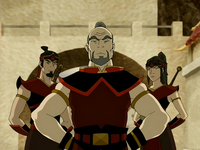
The Fire Nation also employed domestic soldiers.
While most of its military forces are preoccupied with the conquest of the other Nations, the Fire Nation maintains a large and formidable domestic army to defend and enforce the law in both the homeland and a few of the larger mainland colonies. An interesting note about the domestic army is that it employs a surprisingly large number of female warriors and firebenders, who usually do not serve on the front lines. They also serve to train new recruits for both the army and the navy, and as a result most of the military's forces are trained by high-level female firebenders.
History
They have been charged with guarding villages, schools, factories, dockyards, and prisons, and essentially act as a police force.[21] They keep the population in line and are responsible for apprehending criminals, traitors, pirates and anyone who defies the will of the Fire Lord.[22] These soldiers handle the basic training of army and navy recruits from the mainland, and the surrounding islands. Many of the higher officers are veterans from other branches of the military, and thus have significant front line experience and are highly trained.
The domestic army had several encounters with Team Avatar in the weeks following the conquest of the Earth Kingdom. They were first seen when a group of officers spotted Aang in his Fire Nation disguise. They thought that he was a student playing hooky, due to his wearing a school uniform recently stolen to replace his monk attire. They took him to a local Fire Nation school, where he was escorted to a classroom taught by Ms. Kwan. They later assisted the Headmaster when he raided Aang's secret dance party after another student told him about it. The guards tried to catch Aang, but the other students put similar headbands on to confuse them and help Aang escape.[21] Katara saved the local village of Jang Hui from the domestic forces whose nearby factory was polluting the river on which the village was situated. She did this by posing as the village's spiritual guardian, the Painted Lady.[23] Later on, the authorities of Fire Fountain City attempted to apprehend Toph after she used her earthbending to scam the city's local con men and dealers. They managed to capture both Toph and Katara in an attempt to lure in Aang so that an assassin could eliminate him on behalf of Prince Zuko.[22]
On the day before the Day of Black Sun, General Shinu of the army reported to Fire Lord Ozai that earthbender rebellions were preventing total victory in the Earth Kingdom, so he advised sending domestic forces to aid the army overseas. This plan was rejected in favor of a plan to simply burn down the Earth Kingdom using Sozin's Comet.[18]
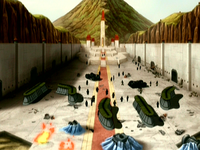
Domestic forces engaged the invasion force on the Day of Black Sun.
The next day, the domestic army was called forth to defend the Fire Nation Capital in the attempted Invasion of the Fire Nation, led by Aang and his allies.[24] The domestic army was badly beaten as the invaders destroyed dozens of tanks and forced the army to retreat when the eclipse occurred, rendering them powerless. However, as the eclipse passed and the invasion subsequently failed, the domestic army retaliated by deploying their air force and bombing the invasion force.[25]
Finally, the domestic army attempted to prevent the traitorous Prince Zuko and his allies from escaping the Boiling Rock, the Fire Nation's most secure prison. This failed miserably when Mai stopped the guards from killing Zuko. When she and her friend Ty Lee betrayed Princess Azula, who was at the prison with them, they arrested the two girls and locked them away.[26] They were released after the War's end.[27]
Infantry
Uniform
These soldiers do not utilize the thick armor seen on front line soldiers, as few of the Fire Nation's enemies have ever managed to approach the homeland. Instead, these warriors only wear light armor with black shirts and pants underneath. Most of them wear headbands with various Fire Nation emblems on them, but Boiling Rock prison guards have been seen wearing helmets with golden visors as opposed to skull masks.[28] Male warriors are fully clothed, but female soldiers wear shirts that expose their midriffs. Also, all warriors wear short sleeves. This light armor serves their policing duties better, allowing the pursuit of suspects without heavy armor slowing them down.
The color of shoulder and chest-plate armor also denotes the rank of an officer in ascending order: rusty red, gold trim and bright red trim.
Equipment and weaponry
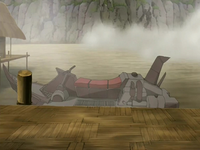
The domestic army has access to almost all of the weapons and vehicles used by the front line forces, among them tanks, airships, warships, etc. A vehicle exclusive to the domestic army is the jet ski, a two-man water vehicle that can travel at fast speeds in order to intercept trespassing vessels. The defenses of the Fire Nation capital showed extensive use of ballistae that fired harpoons and explosive shells.[24]
Nonbenders in the domestic army employ the use of swords and spears for basic defense.
List of known commanding officers
- General Mung
- The warden of the Boiling Rock
- Warden Poon
- Constable Sung
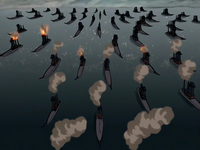
Admiral Zhao's massive fleet attempted to conquer the Northern Water Tribe.
As a result of the Fire Nation being an archipelago, its navy is a key part of its armed forces as it is required to project the Fire Nation's power and soldiers to foreign territories. The Fire Nation thus maintains a large standing navy. The navy is composed of hundreds of coal-powered, ironclad vessels, manned by firebenders as well as regular troops. Using these massive warships, the Fire Navy can launch incredible amphibious assaults, like the great siege of the Northern Water Tribe.[10] The Fire Nation Navy is the largest and most powerful in the world, capable of dispatching over a hundred warships in larger operations.
The Fire Nation Navy is highly organized and stratified, with a clear hierarchy and efficient bureaucracy. All soldiers are expected to defer unquestioningly to their superiors. The navy's movements are coordinated by messenger hawk through various towers placed strategically throughout the ocean, and all towers are required to stay current on all navy movements.[29]
History
The Fire Nation owed many of its victories in the century-long War with the Earth Kingdom and Water Tribes to its navy. It deployed thousands of firebenders to the front lines to fight in the land war against the Earth Kingdom and was capable of bombarding enemy coastlines as well as raiding defenseless settlements.
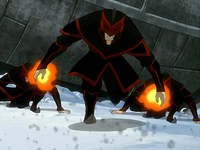
Southern Raiders attacking during the Southern Water Tribe raids.
One of the navy's most notable actions was its prolonged campaign against the Southern Water Tribe. In the opening stages, the navy bombarded the defenseless coastline, losing only a few ships to the valiant waterbenders. The Southern Raiders – a raiding group within the navy – were deployed to capture all waterbenders in the tribe, and their success resulted in the imprisonment of all Southern waterbenders, save for Katara. The tribe was left in ruins due to the actions of the navy.[8][29]
Prince Zuko used his personal ship to hunt down the Avatar. However, his ship was among the weakest and smallest in the fleet, and was eventually destroyed in a failed attempt on his life staged by Admiral Zhao.[30]
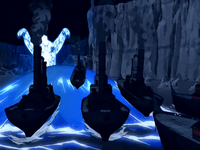
Aang and the Ocean Spirit decimating the Fire Navy.
When Aang was in the Northern Water Tribe to learn waterbending, Zhao assembled a massive naval invasion force to destroy the Northern Water Tribe, and this fleet leveled much of the capital city and deployed hundreds of assault troops onto the shores.[10] Aang's timely intervention, however, allowed he and the Ocean Spirit to merge and annihilate this fleet. The loss of Zhao's fleet proved to be an enormous defeat for the Fire Nation, but did little to slow the Fire Nation's war effort.[12] However, the Fire Nation's interest in the Water Tribes waned.
Despite the loss of Zhao's fleet, the Fire Nation still clearly controlled Earth Kingdom waters and their ships prowled about within Ba Sing Se's vicinity.
During their journey across the Serpent's Pass to Ba Sing Se, Team Avatar and their allies were engaged by a single Fire Nation cruiser patrolling the local waters. However, Aang managed to damage this vessel and forced it to retreat.[31] Shortly before Ba Sing Se fell, Chief Hakoda of the Southern Water Tribe and his men were charged with defending Chameleon Bay, a body of water that led directly to the city. They used tangle mines to ward off Fire Nation warships, thus preventing any means of attacking the city by water.[32] One such engagement saw four Fire Nation warships fight Hakoda's warriors. The Southern warriors were successful in fighting these ships.
After Ba Sing Se fell to the Fire Nation, the Fire Nation sent troops with its massive fleets to occupy the city.[14] The Fire Navy remained at sea, picking off the Fire Nation's enemies, and hundreds of vessels remained active on the seas.
Ships and weaponry
Ship types vary from huge vessels like those of the empire class, to smaller vessels such as Zuko's ship. These vessels serve many purposes, from ferrying and disembarking troops to providing bombardment with their catapults to creating blockades and transporting cargo.[2]
Design
The Fire Nation is a pioneer of warship design, using advanced metallurgy on all warships.
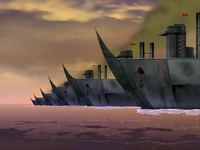
Warships make use of metallurgy and strong bows.
Most ships in the Fire Nation Navy have a heavy releasable bow at the front of the ship, which shares some characteristics with that of a real-life Icebreaker. As the bow also acts as a landing exit, it can be used to batter through walls to create a landing point for ground troops, as shown in raids on both the Northern and Southern Water Tribes.[10][29]
Many of the ships vary in size and appearance to reflect its status and role. For example, Admiral Zhao's flagship had a large dragon on the hull during the Siege of the North.[10] Princess Azula's royal barge also had several spikes on its hull as well as a pagoda command tower or bridge.[33]
All warships are equipped with semi-automatic trebuchets for attack and defense.
Armament
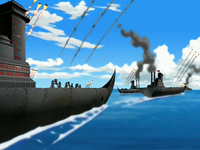
Fire Nation ships attacking.
The Fire Nation Navy uses metal semi-automated trebuchets on all warships, operated by trebuchet operators. These engines work by setting a ball of coal in a shovel-like placement that is attached to a machine and held stationary with rope. The coal-ball is ignited and the rope is cut; this causes the bar holding the placement to fling over and toss the ignited coal-ball into the air. Fire Navy ships can also be armed with ballistae that fire harpoons.[2]
Classes
The only named ship class is the empire-class battleship, a huge warship capable of carrying a crew of thousands.[34] However, other unnamed ship classes are also seen, here with non-canon classes according to function:
- Empire-class battleship - Admiral Zhao's vessel was the huge flagship of the Fire Nation armada that attacked the Northern Water Tribe capital. Twice the length of a standard cruiser, it possessed an ornate bow resembling the head of a dragon.[10]
- Fire Nation cruiser - The mainstay of the Fire Navy, these huge ships carry a large crew and armament. Some variants are armed with three trebuchets in a line, while others have five trebuchets. One cruiser was even seen armed with ballistae. The ships are steam-powered, with two smoke stacks and a massive command tower aft amidships. They have spike-shaped bows that can be used as rams and lowered to form ramps.
- Zuko's ship (outdated cruiser) - Zuko's ship, while fairly large in general terms, was small compared to standard cruisers (about half-size in all dimensions). It was an old ship from the early days of the Hundred Year War.[35] This ship appears to be the same class as the shipwreck, the old Fire Navy ship stuck in ice on the South Pole.[36] Zuko's ship was armed with a single catapult, rather than more modern trebuchets.
- Kayak - Some Fire Navy ships possess kayaks or small lifeboats deployable through a side hatch on the hull. Zuko used one of these ships to infiltrate the Northern Water Tribe.[10]
- Prison ferry - Used to transport earthbending prisoners in the western colonies to the prison rig.[5]
- River steamer - A metal, steam-driven river raft Zuko used first to chase Aang to the Avatar Temple on Crescent Island[37] and in his hunt for the gang after they steal a waterbending scroll from some pirates. The pirates later commandeer this particular boat when their own sloop is taken by the Gang, and run both down a waterfall.[38] Zuko's ship held at least this one steamer, and they may be standard issue in the Fire Navy.
- Riverboat - Admiral Zhao used a series of wooden riverboats to traverse through narrow rivers in his search for the traitor Jeong Jeong and the Avatar. All of these particular boats got destroyed by Zhao's reckless firebending, after some goading by Aang.[39]
- Royal barge - Azula's royal barge was fast and large, complete with a highly ornate bow and a large pagoda-style conning tower. However, the ship seems more representative than made for actual fighting, probably relying more on an armed escort, as it is sleek, has no visible armaments and the house-like tower looks rather fragile.[33] Fire Lord Ozai also possessed his own unique personal vessel, which was briefly seen before his departure to the Earth Kingdom prior to the arrival of Sozin's Comet. The ship appeared to be slightly larger than Azula's ship and again highly ornate. Like all Fire Nation vessels, it sports a large conning tower on a large base.[18]
- Southern Raiders frigate - The Southern Raiders make use of this warship variant. Smaller and faster than the traditional Fire Nation ships, the Raiders' ships are perfect for attacking coastal villages. Their smaller size and improved maneuverability allow the ships to pull up close to the shore and surprise the enemy. One of their special technologies is a large set of dual paddle wheels used to propel these ships through the waters.[29]
List of known commanding officers
- Admiral Chan, leader of the Eastern Fleet
- Admiral Jeong Jeong (prior to desertion)
- Admiral Liang, leader of the Western Fleet. He was reported to be in Ba Sing Se shortly after its capture, and also led Fire Navy forces in conquering the East Lake.[40]
- Admiral Zhao, overall leader of the navy[41]
- Captain Li
- Fire Navy officer
Air force
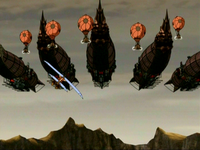
Fire Nation air force.
The Fire Nation was the first of the four nations to develop flying machines for military purposes; war balloons and airships. It should be noted that the war balloons were designed by the mechanist, an Earth Kingdom citizen,[3] and that the airships were made using the balloons as a base. Being able to control the skies gave the Fire Nation an almost insurmountable advantage over its enemies.
History
For most of the course of the Hundred Year War, the Fire Nation was not known to have utilized any true air force against its enemies. However, after the battle for the Northern Air Temple, the Fire Nation acquired a war balloon, a hot air balloon designed by the mechanist, an Earth Kingdom inventor who the Fire Nation had pressed into service by designing weapons and technology. As stated by War Minister Qin, "This defeat is the gateway to many victories."[3] Toward the end of the invasion of the Fire Nation, it was revealed that the Fire Nation had constructed many more war balloons which are now fueled by firebenders, as well as several massive metal airships.[25]
The Air Force aided Azula in tracking down Team Avatar after Sokka and Zuko freed Hakoda, Suki, and Chit Sang from the Boiling Rock. After a short battle at the Western Air Temple, the team managed to escape on Appa.[29]
The airships served a critical role in Ozai's plan to destroy the Earth Kingdom by harnessing the power of Sozin's Comet. Although the attack razed much of the western coastline, the airships were all captured or destroyed when Avatar Aang and his friends defeated Ozai and sabotaged the attack. This attack essentially destroyed the Fire Nation air force, as the bulk of its power had been invested in the airships.[27]
Hot air balloons
- Main article: Hot air balloon
The Fire Nation hot air balloon, also called the war balloon, is a simple airborne vehicle comprised of a large red balloon with the Fire Nation insignia and a personnel gondola underneath. The balloon is fueled by a coal furnace set alight by a single firebender while a second firebender launches projectiles at air or ground-based forces.[3]
Airships
- Main article: Fire Nation airship
Airships are massive aerial warships made of metal, with dozens of crew members. They are primarily used for bombing ground targets, and have dozens of small platforms from which firebenders can attack airborne enemies, and also defend the body of the ship. The airships float using large fuel cells on the bottom of the hull to heat the air inside.[25] The airships played a large role in the last stages of the war, as they made up the battle force with which Ozai planned to burn down the Earth Kingdom during the passing of Sozin's Comet.[18]
List of known commanding officers
- Fire Nation airship captain
- Princess Azula
- Phoenix King Ozai
Special task forces
Yuyan Archers
- Main article: Yuyan Archers
The Yuyan Archers are Colonel Shinu's highly skilled unit of archers, and are, according to Zhao, "capable of pinning a fly to a tree from one hundred yards away, without killing it".[42]
Imperial Firebenders
- Main article: Royal Procession
The Imperial Firebenders are an elite group of firebenders dressed in unique armor serving to protect members of the Royal Family.[33] They were banished by Azula just before Sozin's Comet arrived, as she belived they could not be trusted and would eventually betray her.[43]
Rough Rhinos
- Main article: Rough Rhinos
The Rough Rhinos were an elite group of Fire Nation cavalry, founded by Colonel Mongke. There were five members of the group, each of whom carried a different specialized weapon. They were highly skilled and able to ride their komodo rhinos silently through the brush.[39][44] After the Hundred Year War, the Rough Rhinos left the military to become mercenaries.[1]
Southern Raiders
- Main article: Southern Raiders
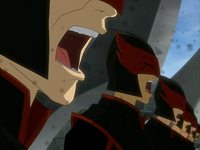
The Southern Raiders are comprised of an elite force of vessels and soldiers tasked with launching the numerous raids on the Southern Water Tribe.
Their insignia is a sea raven and their uniforms are slightly different from conventional Fire Nation armor. Their helmets have red eye shields that extend to the sides with two spikes on each side in the resemblance of flames or wings and the armor is all black except for red outlining along the edges. The commander has a more intricate helmet in that he has no eye shield but has three red spikes extending outward, a curved red spike outlining the eyes, a black nose guard that extends down, spikes near the mouth, and finally spikes on the arm guards.
Their flagship is fairly advanced, with an unusually large conning tower. The goal of the Southern Raiders is to eliminate all the waterbenders from the Southern Water Tribe, as well as stealing supplies for the Fire Nation.[29]
List of known commanding officers
- Southern Raiders commander
- Yon Rha (retired in 96 AG)
Strategies
The Fire Nation military forces seem to favor a strategy that symbolizes their bending art. The Siege of the North showed that the Fire Nation uses heavy bombing with their fleets before overpowering the enemy with armored vehicles, heavy cavalry, and heavy infantry. After gaining a foothold the Fire Nation usually clears the area by advancing at great speeds with cavalry and tanks. After the first advancement, the Fire Nation military usually swarms over the area with infantry. Other strategies are not shown but they are known to make use of maneuver warfare and for encircling their enemy.